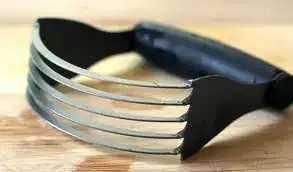I would wager, however, that you are doing two things wrong and if you stopped them, your scones would be as delicious as the biscuits I regularly serve.
The most likely culprit is that your butter is too warm. You want that butter to be as icy cold as a witches heart. All the flaky and delicious is because that butter is going melt once the gluten is set and not before. You can facilitate that melting by sticking the cubed butter in the freezer for a few minutes so it's as firm as possible. Once you have it in the dough, you also want to get into the oven as quick as possible.
The second most likely thing is over mixing. With any quickbread like scones, the less you touch, the better it will come out. You want to mix the milk, butter and flour until the dough just comes together and minimize the amount of rolling out that you do. The less you handle, the less gluten build up you will have, and more tender and flaky your final product is.
Update
Okay, now that we have a recipe, I'm going to double down and say you have a combination of both the above problems. On step 1, do not use your fingers. Fingers are great mixing tools for a lot of things, but scones are not one. You should instead cut the butter into the flour. If you have a tool like this:

then use that, otherwise you can use a fork. The resulting mixture should look sort of flaky and crumbly. The big thing is, you should have no un-buttered flour when you get done. If the butter seems really soft by this point, just toss the whole thing into the freezer for five minutes, otherwise continue. Add the buttermilk (and you should use the buttermilk for a lot of chemical reasons that I just don't feel you will be interested in, but it is important to the amount of rise you get), making sure to mix as little as you need to get the whole thing to come together.
We are going to ignore the last sentence of step three, because whom ever wrote this recipe hates new cooks with the fiery passion. Instead, you are just going to plop the dough down and form it into a sheet suitable for cutting. You should be mere moments away from sexy British scones and tea. The last and final bit of advice comes with a nod to GdD, as your oven temp can probably be adjusted to maximize your rise. I won't really worry about it, though, as the temp in the recipe should yield decent results.
